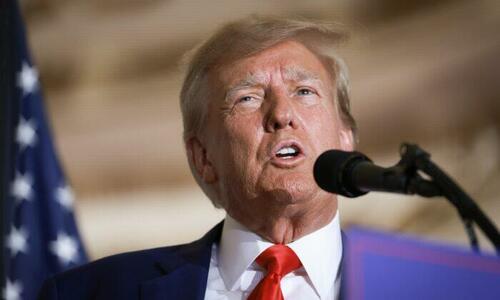


The Trump administration has unveiled an early discretionary spending request ahead of its formal FY2026 budget submission. The proposal aims to cut discretionary funding by $140 billion - roughly 0.5% of GDP, and significantly shift the balance between defense and non-defense spending.
According to Goldman Sachs' Alec Phillips, the proposal would reallocate $119 billion (0.4% of GDP) from non-defense agencies to defense and border-security-related activities. This includes a $163 billion allocation for FY2026 as part of a broader $325 billion funding assumption for defense and border security within a forthcoming budget reconciliation package. Non-defense agencies - excluding departments such as Homeland Security and Justice - would face an average cut of 23%.
Yet, these headline figures may exaggerate the near-term fiscal impact, as Congress is likely to authorize higher spending than the White House proposes, resulting in only a modest 1% decline in discretionary spending in real terms for FY2026.
The Office of Management and Budget (OMB) is proposing a $140 billion reduction in discretionary funding, equivalent to 0.5% of GDP, for FY2026. Of this, $119 billion (0.4% of GDP) would be shifted from non-defense to defense spending, with civilian agencies outside of Homeland Security and Justice facing average cuts of 23%.
This marks a sharp shift in tone from previous administrations, including the first Trump term, which often signaled concern about the deficit but ultimately supported expansive spending. As Academy Securities notes:
“Unlike in Trump 1.0 (and pretty much in every other administration which all claimed to be somewhat cautious on the deficit but then spent on everything), there is austerity here.”
The proposal assumes Congress will provide $325 billion in funding for defense and border security in the upcoming reconciliation package, with $163 billion allocated for FY2026.
Despite the headline cuts, Phillips anticipates only a modest decline in actual spending from this segment in FY2026 for several reasons:
These points suggest that the actual decline in spending will be far smaller than top-line figures imply.
From Academy Securities’ vantage point, that could help assuage markets:
“That should help interest rates if it looks like the budget can progress without the austerity measures being dramatically reduced (always a possibility in D.C.).”
Phillips projects that Congress is unlikely to settle spending totals for this segment of the budget until much later in 2025. A reconciliation bill that includes supplemental funds for defense and border security is not expected before early August, while standard appropriations bills could take even longer.
This raises the risk of a government shutdown when the new fiscal year begins on October 1, though analysts expect the government to operate under continuing resolutions (CRs) that keep funding flat in nominal terms - possibly well into 2026.
As Academy notes, these delays may begin to have market effects:
“Negotiations will start to move markets in the coming weeks.”
Even with slightly lower discretionary outlays, Goldman forecasts a 1% real decline in the portion of federal spending that contributes to GDP. However, this is outweighed by rising mandatory spending, which continues to grow due to entitlements and interest obligations.
On the revenue side, Goldman expects:
Academy Securities adds a key nuance:
"Only additional or new tax cuts will really be stimulative. The extension of existing cuts... won’t be a boost to the economy since virtually no one is adjusting their spending on the assumption that those won’t be extended."
In other words, extending the current tax cuts may prevent a drag on consumption, but will not provide meaningful new stimulus. Conversely, failure to extend them could cause a sharp pullback.
Ultimately, Goldman projects:
The 2026 budget proposal introduces a rhetorical commitment to austerity that differentiates it from past White House strategies. But procedural hurdles, slow disbursement of prior-year funds, and political resistance in Congress suggest that the real-world impact on fiscal aggregates may be modest—at least in the near term.
Markets are likely to begin reacting as budget negotiations progress, particularly as the fate of tax policy and defense spending becomes clearer.

